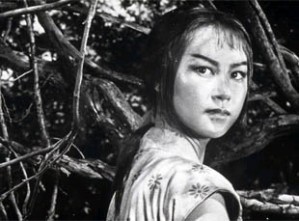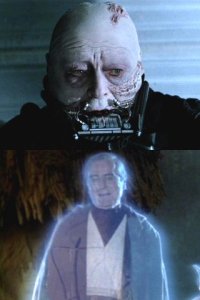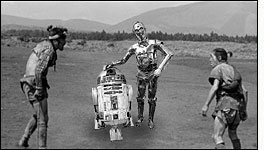An allusion to the origins of Star Wars, the opening text mentions a “period of civil war” and a “hidden base”, both crucial elements of “The Hidden fortress”.
George Lucas made a very famous and successful franchise out of what was originally Akira Kurosawa’s The Hidden Fortress. Star Wars, Episode IV: A New Hope (1977), adapted the story of The Hidden Fortress in several ways. In addition to utilizing the “screen wipe” present in The Hidden Fortress, Lucas borrowed the concept of presenting the story from the perspective of the lowest characters in A New Hope, as well as drawing from themes present in other Kurosawa films, such as the Master/Disciple relationship present in Seven Samurai and Stray Dog, among others.
In The Hidden Fortress, two commoners drive the story through their greed for the gold that they are forced to carry in order to help their princess re-establish her clan, which had been destroyed in a civil war with a neighboring clan. Led by the samurai General of the Akizuki clan, Makabe Rokurōta (Toshiro Mifune), the small band travel through enemy lines and overcome dangerous obstacles to reach safety.
Star Wars has many things in common with The Hidden Fortress. The two comical commoners would become the robot droids R2D2 and C3PO featured throughout the Star Wars franchise. The characters of the Princess and the General translated to Star Wars as well. Both Princess Akizuki (Misa Uehara) and Princess Leia (Carrie Fisher) lose their homelands at the hands of their enemies. Obi-Wan Kenobi (Alec Guiness) is the samurai-like Jedi, who along with antagonist Darth Vader, in the prequel, Star Wars, Episode II: Attack of the Clones (2002) is revealed to have been a former Jedi general.

Darth Vader, formerly the Jedi Knight Anakin Skywalker (Hayden Christensen), was disfigured, having been transformed into a cyborg due to his loss of limbs and subjection to severe burn wounds in battle during Star Wars, Episode III: The Revenge of the Sith (2005). This correlates with the enemy general who allowed General Rokurōta to escape his camp out of respect for Rokurōta’s skill and unequaled moral conduct. He was later scarred by his lord as punishment for this act of compassion, and subsequently betrays his army and joins Rokurōta’s band. Darth Vader as well, betrays his lord and master in order to save his son, Luke Skywalker (Mark Hamill), and thus finds redemption by sacrificing his own life in Star Wars, Episode VI: Return of the Jedi (1983).

Borrowing further from Kurosawa, Lucas incorporated the master/disciple relationship as a fixed feature of the Star Wars franchise. Most notable among them are relationships between Luke Skywalker and Obi-Wan Kenobi, Anakin Skywalker and Kenobi, and Darth Vader and Darth Sidious, also known as Emperor Palpatine (Ian McDiarmid). Putting a new and unique spin on the theme, Lucas had the villainous Sith operate on a master/disciple rule of existence throughout the films: only two may exist at any one time; one the master and one the disciple, who seeks the power and title of his teacher and must prove himself worthy of it by one day killing the master.
Even with the heavy influence of Kurosawa apparent in the Star Wars films, Lucas also falls prey to the typical American condition. Almost all of his heroes are white. While there are heroic aliens such as Chewbacca, Solo’s right hand man, the only prominent humans who are not white are Lando Calrissian (Billy Dee Williams), a significant supporting character in Star Wars, Episodes IV-VI, he is a black entrepreneur who is the best friend of space-gunslinger Han Solo (Harrison Ford), and Jedi Master Mace Windu, portrayed by African-American actor Samuel L. Jackson in Star Wars, Episodes I-III.
In a reflection of the increasing level of tolerance that was developing in American society with the advent of the Civil Rights movements of the 1960’s and 1970’s, Star War, Episodes IV-VI feature the totalitarian, villainous Empire comprised of all white men and women. They all wore uniforms of monochromatic white, grey and black, cut in the style of the infamous Nazi Germany regime. By having the Sith use only light sabers which were red in color, Lucas tapped into the popular romanticized memory of the Nazi Regime as the classic enemy of the American people via the color scheme his films would associate with evil. By utilizing a coalition of aliens and humans as the heroic Rebel Alliance in these films, the message was sent to audiences that tolerance and diversity would win out over intolerance and homogeneity.
